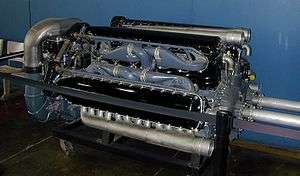Allison V-3420
| V-3420 | |
|---|---|
 | |
| Allison V-3420 Engine | |
| Type | Liquid-cooled W-24 piston engine |
| National origin | United States |
| Manufacturer | Allison Engine Company |
| First run | 1937 |
| Major applications | Fisher P-75 Eagle |
| Developed from | Allison V-1710 |
The Allison V-3420 was an American large experimental W-configuration American piston aircraft engine, designed in 1937.
Design and development
In 1937, at the behest of the United States Army Air Corps, the Allison Engine Company agreed to design and build a large-displacement high-power aircraft engine. The resulting V-3420 was essentially a pair of 12-cylinder Allison V-1710 engines mated to a common crankcase with a 30° angle between the inner cylinder banks. The crankshafts of the two V-1710 engines were geared together to drive a common propeller shaft. Most V-3420 parts were interchangeable with those for V-1710-E and -F engines.
The V-3420 had a power-to-weight ratio of 1.6 kW/kg or 1 hp/lb, excellent for its time. It was envisioned as a powerful yet compact engine for several advanced Air Force projects of the day, including the Douglas XB-19, the Boeing XB-39 Superfortress, the Lockheed XP-58 Chain Lightning, and the Fisher P-75 Eagle. As none of these designs saw more than limited production, only about 150 V-3420s were built.
Variants
- V-3420-A16R (-11)[1]
- V-3420-A16L (-13)[1]
- left hand rotation of propeller, single-stage supercharger with single-stage turbocharger and intercooler
- V-3420-A18R (-17)[1]
- V-3420-A24[1]
- Supercharger ratio 7.2:1
- V-3420-B (-23)[1]
- Similar to the -A but with mechanically driven supercharger in two variable speed stages.
Applications
Specifications (V-3420-A18R (-17))
Data from Aircraft Engines of the world 1946[1]
General characteristics
- Type: 24-cylinder turbosupercharged double-"Vee" liquid-cooled piston engine
- Bore: 5.5 in (139.7 mm)
- Stroke: 6 in (152.4 mm)
- Displacement: 3,420 in3 (56 L)
- Length: 97.7 in (2,482 mm)
- Width: 60.0 in (1,421 mm)
- Height: 38.7 in (863 mm)
- Dry weight: 2,655 lb (1,204 kg)
Components
- Valvetrain: Single overhead camshaft per 6-cylinder block, two intake and two exhaust valves per cylinder, sodium-cooled exhaust valves.
- Supercharger: Single-speed one-stage gear-driven supercharger
- Turbocharger: General Electric turbocharger with intercooler
- Fuel system: Bendix-Stromberg PR-58B3 three-barrel injection-type downdraught with automatic mixture control.
- Fuel type: 100/130 Octane
- Oil system: Pressure fed at 60-70 psi (4.2 - 4.9 kg/m²)
- Cooling system: Liquid-cooled with a mixture of 70% water and 30% ethylene glycol, pressurized.
Performance
- Power output:
- Take-off
- 2,600 hp (1,940 kW) at 3,000 rpm at 46.0 inHg / +8.0 Lb boost for 15 minutes
- Military
- 2,600 hp (1,940 kW) at 3,000 rpm at 25,000 ft (7,625 m) for 15 minutes
- Normal
- 2,100 hp (1,565 kW) at 2,600 rpm at 25,000 ft (7,625 m) maximum continuous power
- Max. Cruising
- 1,575 hp (1,175 kW) at 2,300 rpm at 25,000 ft (7,625 m)
- Specific power: 0.76 hp/cu in (34.6 kW/l)
- Compression ratio: 6.65:1
- Specific fuel consumption: 0.41 lb/hp/hr (11 g/kW/hr)
- Oil consumption: 0.025 lb/hp/hr (138g/kW/hr)
- Power-to-weight ratio: 1.0 hp/lb (1.64 kW/kg)
See also
Related development
Comparable engines
Related lists
References
| Wikimedia Commons has media related to Allison V-3420. |
Notes
Bibliography
- Bridgman, Leonard. Jane's All the World's Aircraft 1945-46. Hammersmith, London: HarperCollinsPublishers (1994 reprint). ISBN 000 470831-8
- Wilkinson, Paul H. (1946). Aircraft Engines of the World. London: Sir isaac Pitman & Sons Ltd.